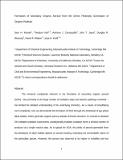| dc.contributor.author | Kessler, Sean Herbert | |
| dc.contributor.author | Nah, Theodora | |
| dc.contributor.author | Carrasquillo, Anthony Joseph | |
| dc.contributor.author | Jayne, John T. | |
| dc.contributor.author | Worsnop, Douglas R. | |
| dc.contributor.author | Wilson, Kevin R. | |
| dc.contributor.author | Kroll, Jesse | |
| dc.date.accessioned | 2012-08-28T20:35:33Z | |
| dc.date.available | 2012-08-28T20:35:33Z | |
| dc.date.issued | 2011-05 | |
| dc.date.submitted | 2011-03 | |
| dc.identifier.issn | 1948-7185 | |
| dc.identifier.uri | http://hdl.handle.net/1721.1/72399 | |
| dc.description.abstract | The immense complexity inherent in the formation of secondary organic aerosol (SOA)—due primarily to the large number of oxidation steps and reaction pathways involved—has limited the detailed understanding of its underlying chemistry. As a means of simplifying such complexity, here we demonstrate the formation of SOA through the photolysis of gas-phase alkyl iodides, which generates organic peroxy radicals of known structure. In contrast to standard OH-initiated oxidation experiments, photolytically initiated oxidation forms a limited number of products via a single reactive step. As is typical for SOA, the yields of aerosol generated from the photolysis of alkyl iodides depend on aerosol loading, indicating the semivolatile nature of the particulate species. However, the aerosol was observed to be higher in volatility and less oxidized than in previous multigenerational studies of alkane oxidation, suggesting that additional oxidative steps are necessary to produce oxidized semivolatile material in the atmosphere. Despite the relative simplicity of this chemical system, the SOA mass spectra are still quite complex, underscoring the wide range of products present in SOA. | en_US |
| dc.description.sponsorship | National Science Foundation (U.S.) (CHE-1012809) | en_US |
| dc.description.sponsorship | American Chemical Society Petroleum Research Fund (50341-DNI4) | en_US |
| dc.description.sponsorship | United States. Dept. of Energy (Director, Office of Energy Research, Office of Basic Energy Sciences, and Chemical Sciences Division of the US DOE (contract no. DE-AC02-05CH11231)) | en_US |
| dc.language.iso | en_US | |
| dc.publisher | American Chemical Society | en_US |
| dc.relation.isversionof | http://dx.doi.org/10.1021/jz200432n | en_US |
| dc.rights | Article is made available in accordance with the publisher's policy and may be subject to US copyright law. Please refer to the publisher's site for terms of use. | en_US |
| dc.source | Jesse Kroll | en_US |
| dc.title | Formation of Secondary Organic Aerosol from the Direct Photolytic Generation of Organic Radicals | en_US |
| dc.type | Article | en_US |
| dc.identifier.citation | Kessler, Sean H. et al. “Formation of Secondary Organic Aerosol from the Direct Photolytic Generation of Organic Radicals.” The Journal of Physical Chemistry Letters 2.11 (2011): 1295–1300. Web. | en_US |
| dc.contributor.department | Massachusetts Institute of Technology. Department of Chemical Engineering | en_US |
| dc.contributor.department | Massachusetts Institute of Technology. Department of Civil and Environmental Engineering | en_US |
| dc.contributor.approver | Kroll, Jesse | |
| dc.contributor.mitauthor | Kessler, Sean Herbert | |
| dc.contributor.mitauthor | Carrasquillo, Anthony Joseph | |
| dc.contributor.mitauthor | Kroll, Jesse | |
| dc.relation.journal | Journal of Physical Chemistry Letters | en_US |
| dc.eprint.version | Author's final manuscript | en_US |
| dc.type.uri | http://purl.org/eprint/type/JournalArticle | en_US |
| eprint.status | http://purl.org/eprint/status/PeerReviewed | en_US |
| dspace.orderedauthors | Kessler, Sean H.; Nah, Theodora; Carrasquillo, Anthony J.; Jayne, John T.; Worsnop, Douglas R.; Wilson, Kevin R.; Kroll, Jesse H. | en |
| dc.identifier.orcid | https://orcid.org/0000-0002-6275-521X | |
| dc.identifier.orcid | https://orcid.org/0000-0003-1627-5618 | |
| dc.identifier.orcid | https://orcid.org/0000-0002-9259-1869 | |
| mit.license | PUBLISHER_POLICY | en_US |
| mit.metadata.status | Complete | |
